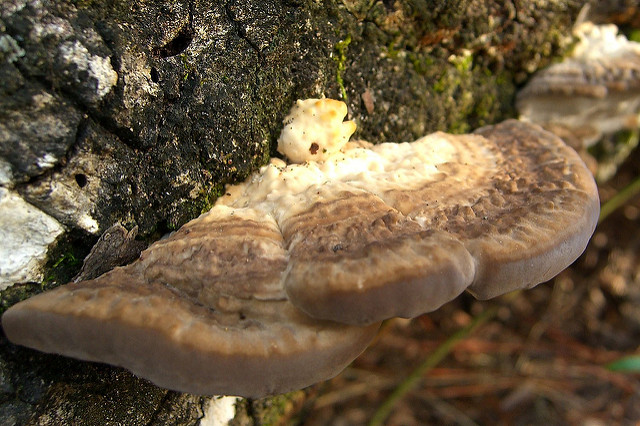This is the first part of a series on fall tree diseases and disorders. This article examines annosum root rot and anthracnose.
Introduction
During fall, the environment undergoes a drastic shift, with cool temperatures prevailing, and inclement weather often abundant. In this climate, many plant diseases flourish. The following describes some of the most common plant diseases to occur in fall, and how they affect their hosts.
Annosum Root Rot (Heterobasidion annosum)
Annosum root rot, also referred to as annosus root rot, is a fungal disease of pine, spruce, and fir trees. The causal agent of the disease is the fungus, Heterobasidion annosum. Heterobasidion annosum is capable of infecting a wide range of host species in forested and landscape settings. It is most problematic in areas that feature an abundance of pines. Annosum root rot is considered one of the most destructive diseases of conifers in the northern hemisphere.
Hosts
Annosum root rot generally targets pines, but it may also affect spruce and fir trees. It is particularly common on white fir. Infections occur on subalpine fir, Douglas-fir, blue spruce, and Engelmann spruce, albeit with less frequency.
Symptoms of Infection
The first symptoms of infection are often most apparent beneath the soil. Once the fungus has infiltrated a tree’s root system, it causes abnormalities to develop in the root structure. These abnormalities inhibit the tree’s vascular system, preventing it from absorbing water and nutrients. More than half of the tree may be killed before infection symptoms become visible. As the infection progresses, the tree’s bark turns pale yellow. Eventually, the bark coloration deepens to a light brown before transitioning to white, with a speckling of irregular black dots. Resin flow may be evident at the root collar, an indication of the tree’s attempts to fend off the pathogen. Infected trees will gradually wither, before finally succumbing to the disease. In landscape settings, a ring of dead trees will gradually develop, with the oldest tree rooted in the center.
In pines, the disease is most active in the sapwood, where it eradicates healthy tissue. While decay may occur in pines, the rapid tissue death often precludes the decay process from becoming too extensive. In spruce and fir trees, the fungus grows in the root collar, often resulting in butt rot. Decay in any host may be preceded by a pink staining of the wood. Later, this decay is defined by pockets, or pits, that form in the wood. Small black flecks can often be observed in the more enlarged pockets. The pockets tend to be lost as the decay process renders the wood spongy, or stringy.
Conks are frequently found in moist sites around white fir. The conks may measure up a foot in diameter. The conks produced by annosum root rot may have a prominent brown cap or bracket. They may also be completely flat on the substrate. The pore surface of the conks is white, with small pores. The flesh is tan. Developing conks often emit a fresh mushroom aroma.
Management
- When planting, select trees that are resistant to annosum root rot.
- A prophylactic stump treatment can be applied immediately after infection to stifle disease progression. Prophylactic stump treatments increase the pH level of the stump to the point where the fungus is unable to survive.
- Several benign fungi are aggressive stump colonizers, and can be administered as stump top treatments to prevent the annosum root rot pathogen from becoming established in susceptible wood.
Anthracnose
Anthracnose is a group of fungal diseases that affect many deciduous and evergreen tree species. It causes dark sunken lesions to appear on leaves, stems, twigs, flowers, and fruit. Prolonged infection can lead to severe leaf blighting, and foliar dieback. Anthracnose diseases are common on ash, maple, oak, dogwood, and sycamore. They may also occur on beech, birch, elm, walnut, and linden, albeit with less frequency.
Hosts
Anthracnose infects a variety of deciduous trees, including ash, basswood, elm, maple, oak, sycamore, and walnut.
Symptoms of Infection
Symptoms of anthracnose vary by tree species, and the causal fungus. General symptoms range from minor necrotic spotting of leaves, to blighting of leaves and shoots. Severe infections can cause leaves to become distorted, and drop prematurely. They may also result in the dieback of diseased twigs and branches. Anthracnose diseases tend to have a greater impact on younger trees, and trees that have been recently planted.
Treatment & Management
Anthracnose can be managed using the following practices:
- Prune and remove any dead wood from trees. Dead tissue is susceptible to infection from anthracnose fungi.
- Remove any symptomatic tissues from the tree, including infected leaves, branches, shoots, and twigs attached to or surrounding the tree. This will help reduce the number of fungal spores available to infect emerging shoots and leaves in spring.
- Maintain overall tree vigor by employing sound cultural practices.
- Ensure that trees are sufficiently watered, especially during dry periods.
- Fertilizing, mulching, and pruning are beneficial to trees. Applying a layer of organic mulch will improve soil quality, and promote healthy tree growth.
- For stressed trees, chemical control practices can be beneficial. Apply a fungicide spray just prior to bud break, before new leaves and shoots expand. Two or three additional sprays should be subsequently applied at ten to fourteen day intervals. Further applications may be necessary during wet or prolonged spring conditions.
Photo courtesy of Jason Hollinger CC-by-2.0


